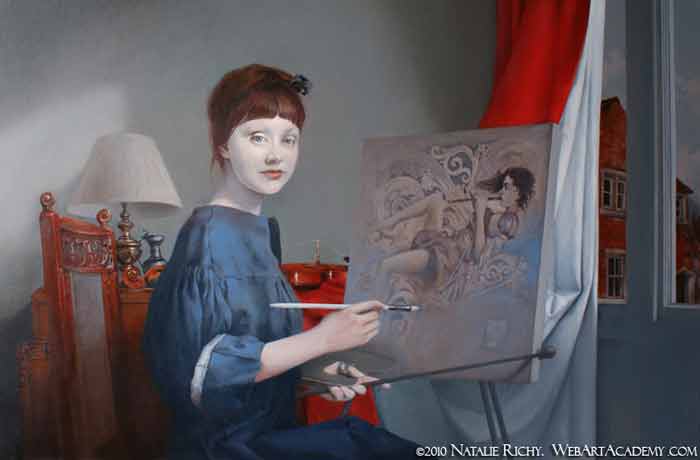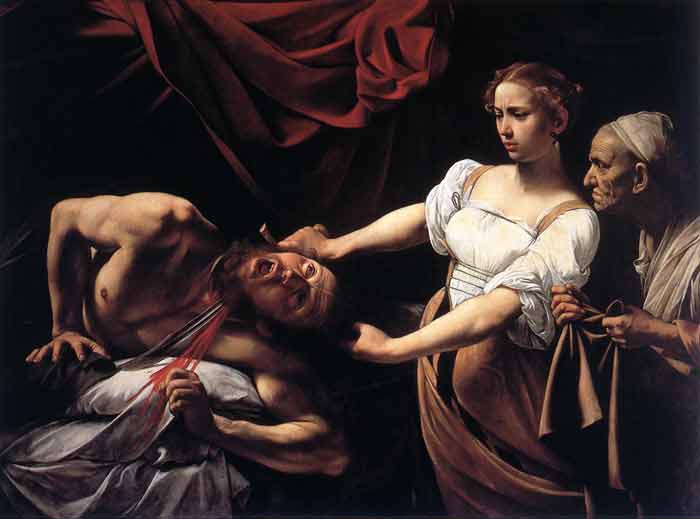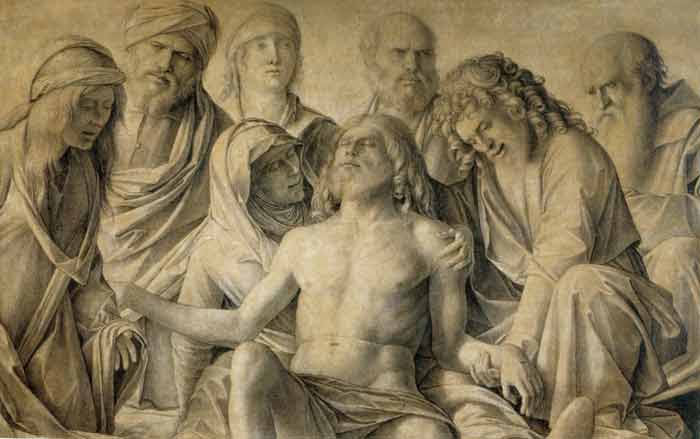On 3 Aug, 2011 With
The Video Lesson “How to Paint a Portrait in Oil” demonstrates the oil painting technique in the style of an 18th century Paris salon, explained in specific, sequential steps. From the positioning of the figure to the details of the background, this easy-to-follow process will give you the discipline and focus that the difficult art of portraiture demands. Oil painting is the process of painting with pigments that are bound with a medium of drying oil — especially in early modern Europe, linseed oil. Often an oil such as linseed was boiled with a resin such as pine resin or even frankincense; these were called ‘varnishes’ and were prized for their body and gloss. Other oils occasionally used include poppyseed oil, walnut oil, and safflower oil. These oils confer various…
Read More
On 10 Jul, 2011 With
Learn from the OLD MASTERS The Ambassadors (1533) is a painting by Hans Holbein the Younger in the National Gallery, London. As well as being a double portrait, the painting contains a still life of several meticulously rendered objects, the meaning of which is the cause of much debate. It is also a much-cited example of anamorphosis in painting. The most notable and famous of Holbein’s symbols in the work, is the skewed skull which is placed in the bottom centre of the composition. The skull, rendered in anamorphic perspective, another invention of the Early Renaissance, is meant to be a visual puzzle as the viewer must approach the painting nearly from the side to see the form morph into…
Read More
On 4 Jul, 2011 With
What Édouard Manet learned from the OLD MASTERS? Manet’s composition reveals his study of the old masters, as the disposition of the main figures is derived from Marcantonio Raimondi’s engraving The Judgement of Paris (c. 1515) after a drawing by Raphael. Scholars also cite two works as important precedents for Manet’s painting Le déjeuner sur l’herbe, The Pastoral Concert, 1508, by Giorgione or possibly Titian (in the Louvre) and Giorgione’s The Tempest, both of which are famous Renaissance paintings. The Tempest also features a fully dressed man and a nude woman in a rural setting, as an important precedent for Manet’s painting Le déjeuner sur l’herbe. The painting Pastoral Concert, even more closely resembles Le déjeuner sur l’herbe, featuring two…
Read More
On 13 Jun, 2011 With
Oil Painting Methods – Oil paintings based on The Last Supper Leonardo da Vinci
Read More
On 26 May, 2011 With
Fine Art Video Lessons Finally Available Online A brand-new video course about classical oil painting and drawing techniques has been launched by the Web Art Academy. The Academy (http://art.webartacademy.com) offers fine art video lessons that reveal, step-by-step, the full process of artwork creation. Art students can now learn by watching the fine artist in action. London UK. A brand-new website offering high-quality fine art instruction has just been launched. The Web Art Academy (http://art.webartacademy.com) reveals traditional oil painting and drawing techniques to fine art students through the use of high-definition video lessons. The Web Art Academy was created to give fine art students a thorough instruction in the almost lost secrets of traditional oil painting and drawing. Natalie Richy and…
Read More
On 16 May, 2011 With
Classical Oil Painting and Drawing Techniques A new Internet-based resource about classical oil painting and drawing techniques has just been released by the Web Art Academy. The Academy (http://art.webartacademy.com) presents fine art video lessons for art students and enthusiasts wishing to improve their creative skills. London, UK. A new website specifically created for the fine art education market has just been launched after more than two years of course development and preparation. The Web Art Academy (http://art.webartacademy.com) is designed to help people easily acquire excellent oil painting and drawing skills and improve their chances of becoming successful and famous fine artists. Natalie Richy and Vladimir London, founders of the Web Art Academy, established the online club to provide students from all…
Read More
On 10 May, 2011 With
Caravaggio’s Oil Painting Technique Carravgio for the most part painted alla prima without any prepatory drawings or cartoons directly onto the canvas. The evidence for this is that over time the underpaintings have become more visable and show how he changed his mind and “searched” for him composition. He used a very limited pallet. David Hockney’s theory on masters using primitive projectors, pointed to Caravaggio’s marks on the wall (in “Judith Beheading Holofernes”) as proof to this for some reason. Its important to know that Hockney is the “conspiracy nut” of the art world who sees logic where there is none and speaks absurdly. Other than that, I have not come across anything as to why there are scratches in…
Read More
On 14 Feb, 2011 With
Painting Techniques – Working in layers Oil Painting Working in layers is used extensively in oil painting for paintings that require more than one session. For a painting that develops over several days, allowing for the oil paint to dry for a given layer, it is helpful to work with explicit painting layers. The first layer may be a ground, usually applied all over the surface. Then an underdrawing in outline may follow. Then comes underpainting, overpainting, and finally semi-transparent glazes and varnish. All of these layers will affect the appearance of the final painting. To understand the role of underpainting, one can use metaphor and think of the underpainting as a base-rhythm in music, and the overpainting as a…
Read More
On 7 Feb, 2011 With
Art Terms: Brunaille A Brunaille is a painting executed entirely or primarily in shades of brown. Such a painting is described as having been painted “en brunaille“. Brunaille has its roots in 12th century stained glass made for Cistercian monasteries which in 1134 prohibited the use of color in their art. However, it was only in the early 17th century that the French term “brunaille” was coined to describe pictures painted in shades of brown. Brunaille are less common than paintings executed in grey (grisaille).
Read More
On 3 Feb, 2011 With
Painting techniques – Chiaroscuro Chiaroscuro (Italian: “light-dark”) in art is characterized by strong contrasts between light and dark, usually bold contrasts affecting a whole composition. It is also a technical term used by artists and art historians for using contrasts of light to achieve a sense of volume in modeling three-dimensional objects such as the human body. Further specialized uses include chiaroscuro woodcut, for coloured woodcuts printed with different blocks, each using a different coloured ink; and chiaroscuro drawing for drawings on coloured paper with drawing in a dark medium and white highlighting. Similar effects in the lighting of cinema and photography are also chiaroscuro. Origin in the chiaroscuro drawing Chiaroscuro originated during the Renaissance as drawing on coloured paper,…
Read More




